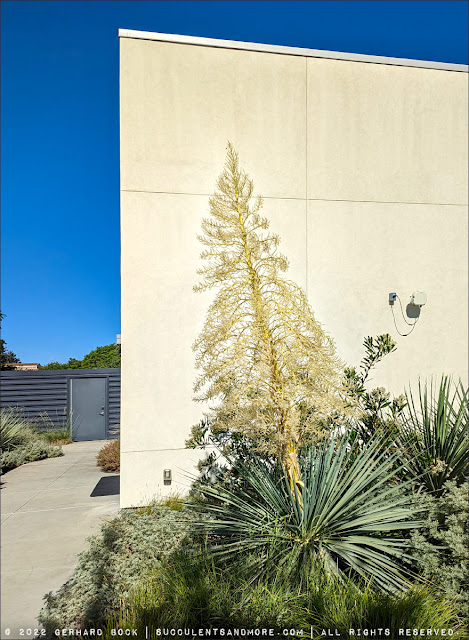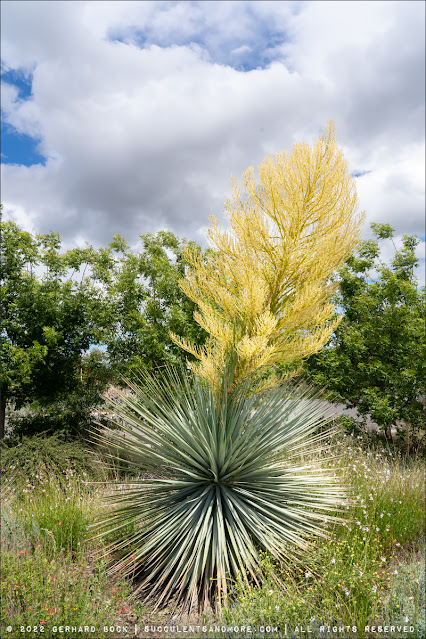Between going on adventure walks with our dog in the Oak Grove and doing volunteer work at the Arboretum Teaching Nursery, I’ve been spending more time this year on the University of California Davis campus. As a result, I’ve been noticing things that I’d missed before—for example, how many blue nolinas (Nolina nelsonii) there are on campus and how spectacular they are in flower. The photos in this post speak for themselves.
The blue nolina (Nolina nelsonii) is native to the mountains of the Mexican state of Tamaulipas. Found at elevations from 7,000 to 9,000 ft., it’s hardy to 0°F. It grows slowly to 8 ft. tall by 3-4 ft. wide, over time forming a trunk somewhat similar to the closely related ponytail palm (Beaucarnea recurvata). Once established, it needs very little to no supplemental irrigation, even in our summer-dry climate.
Judging from where the plants on the UC Davis campus are sited, it flowers equally well in full sun and partial shade.
 |
| The size of the inflorescence is amazing |
 |
| Another one on the far side of the White Flower Garden |
All nolinas (and related genera like dasylirions and beaucarneas) are dioecious, i.e. male and female flowers are found on separate plants. Successful pollination requires both a female and a male. When in flower, male and female plants look very similar. Later in the flowering cycle, male inflorescences begin to look more sparse as the bits and pieces of the flowers dry up and fall off. In contrast, female inflorescences are covered with papery seed capsules, provided they’ve been pollinated. Nolinas are polycarpic, which means they don’t die after flowering (like agaves would).  |
| One of several Nolina nelsonii outside Scrubs Café. This plant is further along in the flowering cycle. |
 |
| Closeup of (male) inflorescence |
 |
| Scrubs Café |
 |
| Scrubs Café, with the Arboretum Teaching Nursery in the background |
 |
| Male flowers with pollen |
 |
| Bits and pieces of flowers falling off and accumulating in the leaves |
 |
| Winged seed capsules on a female plant (seeds are not ripe yet) |
With its strappy blue leaves and stately presence, the blue nolina is a spectacular landscaping plant even when it’s not in flower. But it gets even better: The leaves are flexible and unarmed, which makes it suitable even for high-traffic areas where people might brush up against it.
Compare this to the desert spoon or sotol (Dasylirion wheeleri), a much more common landscaping plant than Nolina nelsonii. It’s popular in Southern California and virtually ubiquitous in Arizona. Dasylirion wheeleri is similar in size and hardiness to Nolina nelsonii, but its leaf margins have wicked serrations. From a distance, it looks soft and cuddly, but up close, it can draw blood.
There’s no doubt that Dasylirion wheeleri is beautiful:
 |
| Dasylirion wheeleri at Tohono Chul Park in Tucson, Arizona |
But I would argue that Nolina nelsonii is a far more suitable landscaping plant. Not only because it’s more user-friendly, but also because its inflorescence is much more impressive. Take a look again at one of the photos at the top of this post and then compare to the photos of Dasylirion wheeleri flower stalks below:
 |
| Dasylirion wheeleri inflorescences, much skinnier and far less showy than those of Nolina nelsonii |
 |
| Dasylirion wheeleri inflorescence |
The one downside of Nolina nelsonii is availability. In California and Arizona, Dasylirion wheeleri is a staple in big box garden centers, not to mention “real” nurseries. Nolina nelsonii is much harder to find. I don’t know why, considering that female plants set copious amounts of seeds and propagation should essentially be the same as for Dasylirion wheeleri. If given a choice, I’m sure that homeowners would pick Nolina nelsonii over Dasylirion wheeleri!
© Gerhard Bock, 2022. All rights reserved. To receive all new posts by email, please subscribe here.




















Incredible inflorescence. Even out of flower the Nolinia is a gorgeous plant. Love it's fountaining form.
ReplyDeleteMe too! A beautiful plant year round.
DeleteI have not researched this yet, but I wonder if the high heat in Phoenix is hard on Nolina nelsonii. You said it is found at elevations from 7,000 to 9,000 ft. which would seem cooler (at least at night) than the Sonoran Desert.
ReplyDeleteI bet you're right. According to ASU, Dasylirion wheeleri grows at 2,000 to 5,000 ft. So it's likely that it can take higher temperatures than Nolina nelsonii.
DeleteYes, I always check where plants come from originally. It is a good barometer as to whether they will grow well and survive in temperatures in June, July, August, September in the Sonoran Desert. In the next couple days we will have 114º or more and hot nights (over 85º) are here. I hope gardeners in many areas of CA and others states understand what is happening here and, down the line, realize what will happen there.
DeleteIt seems I can personally testify to your thesis: I removed Dasylirion wheeleri from the Long Beach garden some years ago but grow and love Nolina nelsonii. It gets better and better with age...but no blooms yet! I want to try it in Oregon too. I did not know the blooms were that spectacular. Amazingly good photos.
ReplyDeleteThat is one beautiful plant - don't believe I've ever seen one. Surprising that it's polycarpic with a bloom like that - it literally blooms its head off! Your Dasylirion wheeleri inflorescences look very similar to those of our Xanthorrhoea. Great photos, thanks for sharing.
ReplyDeleteSaw these in bloom in Joshua Tree. The elevation is about 3000' so maybe okay in Phoenix area.
ReplyDeleteBeautiful inflorescence on that Nolina. My D. wheeleri is flowering for the first time. Won't be removing it--it's way too big! I think of that type of plant nothing can beat Yucca linearifolia. It has a gracefulness to it that the plants with stiffer leaves lack. I wish mine hadn't died. Maybe Y. rostrata as runner up, with the blueness of the foliage some selections have.
ReplyDelete